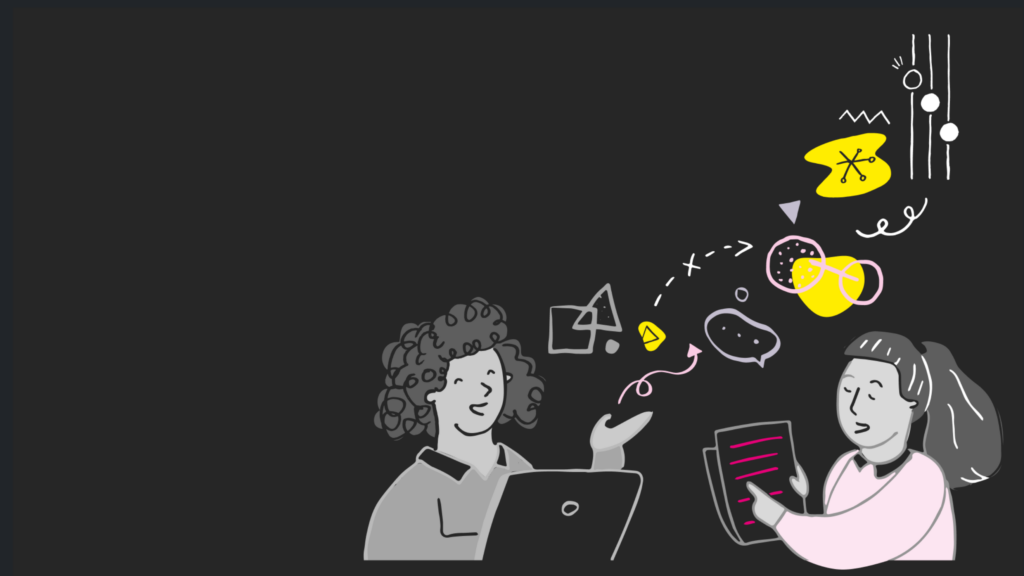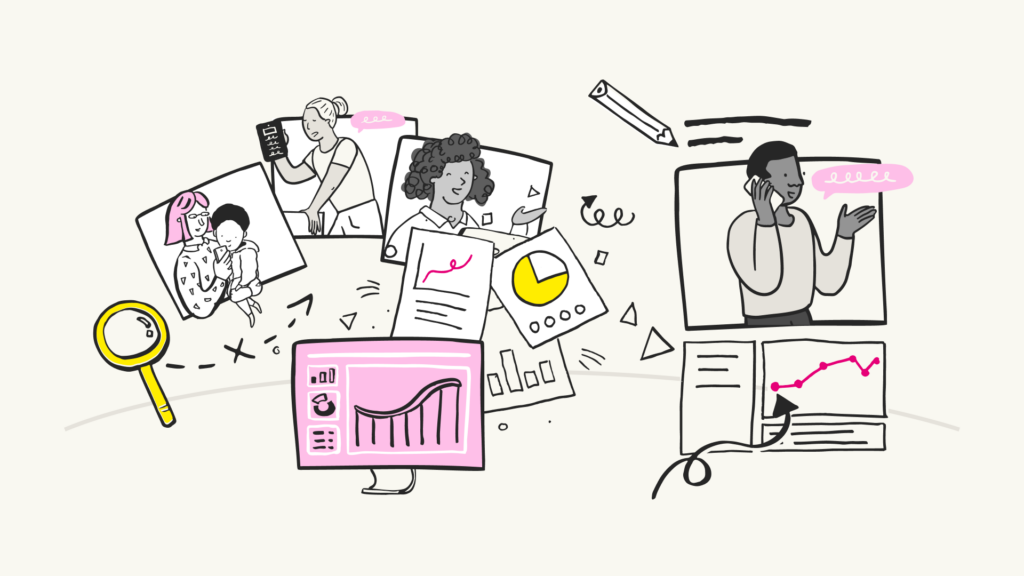
Back in February 2021, we embarked on a 15-month long partnership with NHS Test and Trace. This work spanned content design, accessibility and service design. In particular, we supported Test and Trace by providing user research support and capability across multiple work streams.
We’re incredibly proud of this partnership and the part we played in helping to keep the public safe from the threat of COVID-19. To highlight this work, one of our Principal UX Consultants, Tom Harding, delivered a webinar about our collaboration with them: ‘Building a User Research Function in Test & Trace’.

In this talk, Tom covered his experiences building a user research function in a new team (The Single Digital Front Door team – Testing guidance on NHS.UK). He discussed the challenges he encountered introducing research capability in the team, and how we implemented a collaborative, agile user research framework to ensure the service met the needs of users.
The talk covered multidisciplinary collaboration from the perspective of user research. He details his experience working in blended, cross-organisational teams in agile sprint-based research. As well as how they worked collectively to share policies, improve comprehension and shift user perceptions. So, how did we do it? Read on to find out.
The Single Digital Front Door Team
The main aim of the Single Digital Front Door Team (SDFD) is to help the general public to understand and find the right information and guidance around coronavirus testing. It serves to ‘funnel’ individuals to a centralised space that allows them to access the necessary information to support their goal.
The end-to-end journey is always at the heart of what they do, with focal points including finding the right test, how to get the test, how to take a test, what to do following a test and so on. Key platforms included search, NHS.UK and GOV.UK.

Key challenges
The project presented a number of challenges. The SDFD team were newly formed and had to quickly define new ways of working, governance processes, and create content from scratch – all against a backdrop of a global pandemic.
The team did not yet have an assigned user researcher and relied on research resource from other workstreams. The fully-remote team also had to:
- Deliver an MVP before the launch of universal testing (the free lateral flow testing scheme for England), giving the team less than six weeks to develop content on NHS.UK that highlighted the benefits of the scheme to the general public
- Conduct Rapid Discovery and Alpha phases within this six-week window – an incredibly quick turnaround for this kind of work
- Work around constantly changing policies and programme priorities, which were led by Number 10 and would often change within a matter of days, requiring the team to think on their feet
Tom integrated himself within the SDFD team and supported them by providing user researchers who could act as a dedicated resource. This meant he could help the team as it:
- Built user research capability within the new team
- Delivered rapid and actionable insights
- Helped to define service ownership and content governance
- Navigated shifting programme priorities
- Collaborated in multidisciplinary, blended teams
Where did user research fit?
Stakeholder interviews and mapping were conducted to help the team better understand the value they could bring as user researchers. This ultimately allowed them to identify three core missions:
- Support the overarching goals of the team and help make better services, underpinned by user needs
- Embed research through a framework of continuous research capability, supporting and evaluating mission outcomes and KPIs
- Champion the needs of all users, especially over impacted and underrepresented groups
- Defining our users and their needs
One of the most important stages in any project is defining our users and their needs. So, the SDFD team created a repository of all the user needs they felt were relevant for this particular work stream. They then identified specific themes and touchpoints within the user journey, and hypothesised how they planned to meet each need.
Once needs were defined, the team had to figure out who their users actually were so they could define them in the context of research. They did this by using ‘circumstantial dimensions’ or a ‘circumstantial scale’ – essentially, categorising users based on their circumstances in the context of the pandemic. This was broken down into the following:
- Working arrangements – working from home vs unable to work from home. Household income
- Studying – currently attending school, college or university
- Household composition – living alone, with children or in a school bubble, living with people who are unable to work from home
- Travelling – frequently travelling in and out of the UK
- English as a second language or low literacy
- Vulnerable or high risk – shielding or taking additional precautions to reduce their risk of catching coronavirus
- Disproportionately impacted groups – lower 30% index of deprivation, certain ethnicities, high risk job roles, low household income
- Access needs – low digital literacy, access needs or assisted digital technology
The team then implemented a framework that was underpinned by prioritised user research backlog – essentially, an area that brought together all of the research goals and questions so that they could be tracked as the sprints progressed.

The sprint cycle
The project was delivered via 10-day sprints. Within these, the team aimed to quickly understand and define priorities, prepare and create research plans, and execute, analyse and feed back that research – all in the space of a single sprint.
Week one was focused on prioritisation, understanding the goals of the team, starting to prepare a research plan, recruitment and feeding back to the team. Week two was all about executing the research, analysing the results, debriefing the team and presenting back the insights.
KPIs and impact tracking
KPI and impact tracking was a key part of the process. There was an initial stream that allowed the team to quickly respond to research goals, and a second track that allowed them to measure the outcomes of the designs they were making.
This was a mostly automated process of tracking and evaluating different large-scale data points. For example, analytics from NHS.UK, pop-up surveys and call centre tickets. The overarching goal was to understand the impact of the designs and whether they were meeting user needs and the hypotheses that were originally set. Examples of feedback sources included:
- 119 call enquiry tickets
- GOV.UK feedback
- NHS.UK service feedback
- Hotjar survey responses
- On-site analytics
- Social listening
- Internal and external search
Leaving a legacy
Equally as important as the project itself was the need to create a legacy after it finished, so that the approach used would continue and benefit the whole team. This involved upskilling the team, and sharing our successes and lessons with the wider user research community within Test & Trace.
To do this, a template board and playbook were created to allow implementation of the framework across other teams on Test & Trace. There were also several training workshops with the user research team to help others to adopt a more agile approach in their own teams.
Finally, new user researchers were onboarded onto the Single Digital Front Door Team, and they received training on the framework and how it can be used.
Key learnings
Tom identified six key learnings from the process, summarised below:
- An agile framework allows us to be responsive – the rigidity of a process allows us to be flexible, taking away the thinking and ensuring that we can move together as a single team and address big problems in a systematic way
- Collaboration is key – it’s really important that we collaborate with each other and share our skills across the board
- Tracking success helps you improve (and win hearts and minds) – by being able to quantitatively demonstrate the value of not only your research but the designs you’re doing, you can get buy-in from tricky stakeholders and convince them of the value of the work you’re doing
- Always aim to build relationships outside your team – this was particularly important on Test & Trace because it was a large and confusing environment at times, so a strong network and relationships with wider organisations, user researchers, designers and other teams were extremely important
- Remote research isn’t a bad thing! – it’s highly effective and just as valuable as in person research, and it means you can reach a more diverse range people who may not be able to come in for a session
- Focus on actions and outcomes, not documentation – the true value of research lies in what it can bring to the team and the actual outcome of the work you’re doing, not in shiny decks and documentation
You can watch the full webinar for yourself on our YouTube channel. And if you’d like to learn more about how our user research capabilities could help your team create better services and products, get in touch with our team.
We drive commercial value for our clients by creating experiences that engage and delight the people they touch.
Email us:
hello@nomensa.com
Call us:
+44 (0) 117 929 7333




